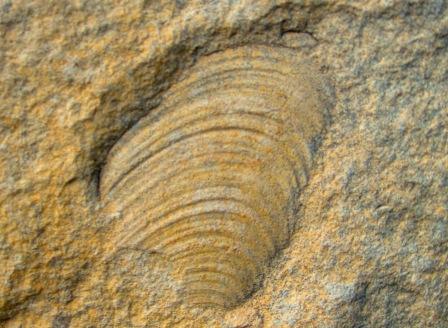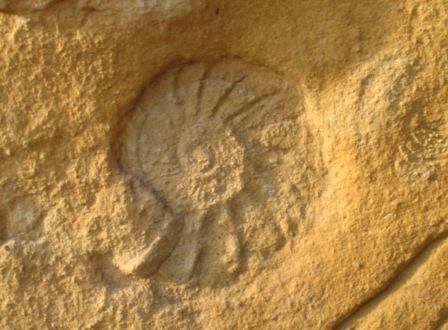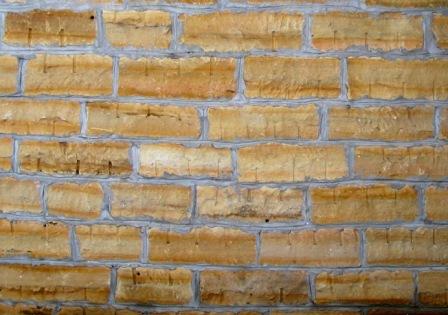The Post Rock Museum
Geology of the Post Rock Limestone
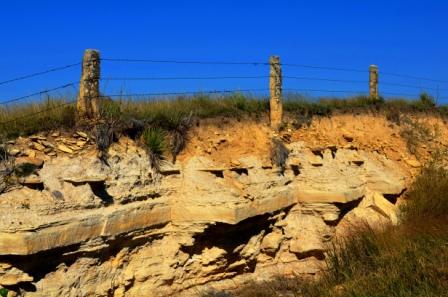
Kansas is divided into 11 physiographic regions. The Smoky Hills region covers an area encompassing most of 23 counties in the north-central part of the state. Rush County is located in the southwestern portion of that region. Outcrops of Cretaceous-age rocks are prominent in the region.
According to the Kansas Geologic Timetable, the Cretaceous Period was the interval of time from 142 to 65 million years ago at the end of the Mesozoic era. During this time, most of the western half of Kansas was covered by an inland seaway. As this seaway receded, it left behind deposits that today compose three principal rock outcrops, Dakota sandstone, Greenhorn limestone, and Niobrara chalk.
The lowermost of these, the Dakota sandstones, outcropping more to the east, are sediments and beach sands from the shorelines of the Cretaceous seaway. The uppermost layer, the Niobrara Chalk, extends in a vein westward from the western range of the Smoky Hills. These chalk deposits were in the deep parts of the Cretaceous Sea and are responsible for the unusual formations of Castle Rock and Monument Rocks in Gove County. It is also known for the discovery of fossils of swimming reptiles. The famous Fish-within-a-Fish fossil (Xiphactinus with Gillicus) on display at Sternberg Museum of Natural History is Hays was discovered in this region along with several plesiosaurs and mosasaurs that inhabited the water while dinosaurs walked the earth.
Situated between these layers is the Greenhorn Limestone, composed of alternating thin layers of chalky limestone and gray shale. The bed, approximately 100 feet thick, is further subdivided into four members. Lincoln limestone, the lowermost, is from 20 to 25 feet thick; Heartland shale, 30 to 35 feet thick; Jetmore chalk, 20 to 22 feet; and Pfeifer shale, 20 to 22 feet thick. At the top of the Pfeifer member is a thin layer of unique limestone, known as a marker bed, called Fencepost limestone.
Eight to twelve inches thick, the Fencepost limestone layer often lies very near the surface (generally no more than three feet) and outcrops abundantly through the central part of the Smoky Hills region. It is this layer for which “Post Rock Country” gained its name. The fencepost layer is very uniform in thickness and free of joints or linear fractures. When first uncovered, the fencepost layer is soft, but after exposure to the air for a prolonged period, the limestone hardens. Since there were few trees in this region to build fences and buildings, settlers were forced to discover alternate materials. They soon discovered that this limestone bed suited their needs.
Limestone posts were also quarried from other layers within the Greenhorn limestone. In Cloud County, posts were quarried from the Shellrock layer about 20 feet in elevation below the Post Rock bed. The Shellrock bed is similar in thickness to the Post Rock, but is greyish-white in color and less consistent. There usefulness was limited, however, as they did not exhibit the strength or resistence to elements as posts from the Post Rock bed. In Ellis County, at the northwestern edge of Post Rock Country, posts were quarried from the yellow Fort Hays limestone. Since this chalky limestone is softer than the Post Rock layer, the posts were considerably wider and crumbled when exposed to the weather.
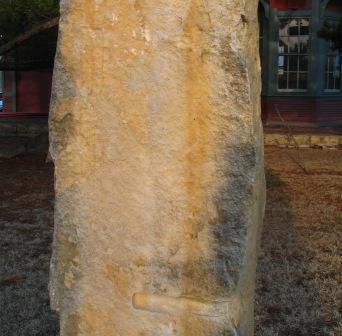
A unique geological feature of Fencepost limestone is its characteristic brown streak (see photo), somewhat uncommon in limestone formations. Located near the center of the bed, the streak is a form of limonite (HFeO2), or more commonly, rust. No exact determination has been made as to the cause of the brown streak, but geologists have discovered a great presence of fossilized shells and driftwood within the brown streak. In Land of the Post Rock, Muilenburg and Swineford explain the source of the iron streak as being “…derived from alternation of finely disseminated pyrite and then redistributed during a process of recrystallizing and cementing of the limestone, followed by oxidation when the limestone is exposed to the air.” When iron rich water from swampy areas was washed up it carried along tree limbs, shells, and other debris depositing them on the shore.
In addition, they have discovered a greater presence of the driftwood in northern areas than in the southern parts of the Post Rock region. The presence of limonite, therefore, may be directly in proportion to the presence of fossil wood. Thus, the position and coloration of the brown streak may also help to pinpoint the locale of fencepost limestone. Muilenburg and Swineford explain:
As we trace the Fencepost bed to the southwest, we can see that the brown streak becomes paler and less “central.” Farther west and southwest it is replaced by two or even three (rarely as many as six) much paler and thinner brown streaks, none of which is central. In the southernmost part of the land of the post rock the streaks are very poorly developed, and the rest of the bed is much paler than the yellowish Fencepost limestone to the northeast.
Fossils Found in Post Rock Limestone
Fossils are not as prevalent in the Post Rock limestone as in other layers. However, a few are frequently found including Inoceramus labiatus, Collignoceras woolgari, driftwood, and sharks teeth and scales.
Inoceramus labiatus, commonly called fossil clams, are easily recognized since they closely resemble modern sea shells. Their sizes and shapes can vary greatly. These clams are also referred to as bivalved mollusks (bivalves) since their shells are composed of two parts called valves. Bivalves can be traced back to the Cambrian Period, about 510 million years ago. Some ancient bivalves lived on the seafloor and attached themselves to rocks or sediment in the same manner as modern oysters.
The ammonite, Collignoceras woolgari, is a relative to the modern squid and octopus, a member
of a class of animals known as cephalopods. Ammonoids are common in the fossil record and can be traced
from as far back as 415 million years ago to the end of the Cretaceous Period about 65 million years ago. Fossils
found in the Post Rock region are the youngest of the lineage.
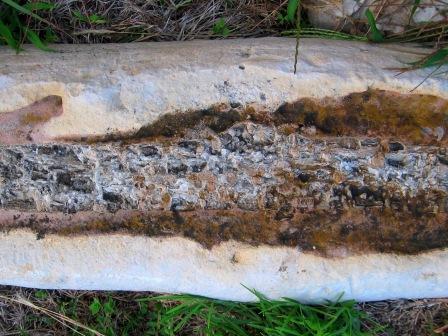
Silicified driftwood is also common in the Post Rock limestone and can vary considerably in
size and shape. Generally, they are considered mini-lignite deposits since the wood has not been
completely replaced as in typical fossilization. Many are scarred with round calcite filled holes
originally bored by ancient molluscs. These molluscs are comparible to the modern ship-worm. Some
specimens also exhibit areas of sparkling quartz crystals.
Fossils within the Post Rock limestone may or may not be visible in buildings depending upon the placement of the stones. Some stones were placed with their grain parallel to the ground with the brown streak and drill marks exposed. Although this provided for strength and gave the wall “character,” exposed fossils were hidden from view. The picture to the right is a closeup of the Post Rock Museum and illustrates this construction method. Occasionally, stones were placed on their sides with the grain perpendicular to the ground to provide more consistency in color and a cleaner surface leaving fossils visible. Many of the buildings on the campus of Fort Hays State University in Hays are constructed in this manner. In fence lines, fossils are generally found on the front and back of the fence posts as posts are generally set with the grain parallel to the wire.
Pictured to the left is a Fencepost limestone exposure beneath a post rock and barbed wire fence alongside a rural road in north central Rush County. According to Post Rock Country by Bradley Penka, “"The multiple layers of the Greenhorn bed are easily visible alongside road cuts in central Kansas. The varied layers are the result of millions of years of sediment deposited by the ebb and flow of the inland sea that once covered Kansas. Geologists study the variations in these layers and through comparison can gain insight to weather conditions, water temperature, and other environmental conditions of the time.” The Fencepost layer is easily distinguished from other layers. Layers of bentonite above and below easily erode away leaving the fencepost bed more prominent.
References:
The Kansas Geological Survey, Geofacts, “Smoky Hills Rocks and Minerals”, April 1999, University of Kansas, Lawrence
Steeples, D.W. and Buchanan, R. C., Kansas Geomaps, “Generalized Physiographic Map of Kansas”, 1984, The Kansas Geological Survey, University of Kansas, Lawrence
Grace Muilenburg and Ada Swineford, Land of the Post Rock Its Origins, History, and People, 1975, University Press of Kansas, Lawrence
Penka, Bradley R. and The Rush County Historical Society, Post Rock Country, 2014, Arcadia Publishing, Mount Pleasant, South Carolina
Kansas Geological Survey “Stratigraphic Nomenclature,” Geology Resources, University of Kansas, 2018, http://www.kgs.ku.edu/General/Strat/Chart/index.html
